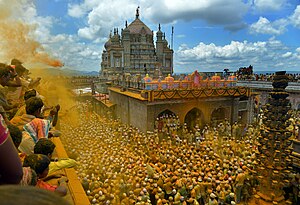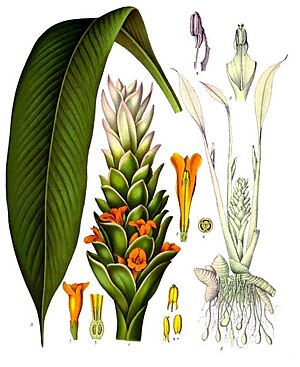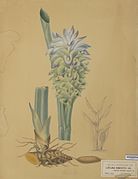Turmeric/ja: Difference between revisions
Created page with "古くからアーユルヴェーダ医学で利用されてきたが、ターメリックまたはターメリックの主要成分であるクルクミンの摂取が病気の治療に効果があるという質の高い臨床的証拠はない。ターメリック植物が生成する鮮やかな黄色の化学物質であるクルクミンは、[[:en:World Health Organization|世界保健機関]..." |
|||
| Line 17: | Line 17: | ||
根茎は生のままでも使用できるが、しばしば水で茹でて乾燥させた後、深みのあるオレンジ色の黄色い常温保存可能なスパイス粉末に粉砕される。これは多くの[[Asian cuisine/ja|アジア料理]]、特に[[Curry/ja|カレー]]([[curry powder/ja|カレー粉]])において、[[food coloring/ja#Natural food dyes|着色]]および風味付けの目的で一般的に使用されている。ターメリックパウダーは、温かく、苦く、[[black pepper/ja|黒胡椒]]のような風味と、土のような、[[mustard plant/ja|マスタード]]のような[[:en:aroma|香り]]を持つ。 | 根茎は生のままでも使用できるが、しばしば水で茹でて乾燥させた後、深みのあるオレンジ色の黄色い常温保存可能なスパイス粉末に粉砕される。これは多くの[[Asian cuisine/ja|アジア料理]]、特に[[Curry/ja|カレー]]([[curry powder/ja|カレー粉]])において、[[food coloring/ja#Natural food dyes|着色]]および風味付けの目的で一般的に使用されている。ターメリックパウダーは、温かく、苦く、[[black pepper/ja|黒胡椒]]のような風味と、土のような、[[mustard plant/ja|マスタード]]のような[[:en:aroma|香り]]を持つ。 | ||
古くから[[Ayurvedic medicine/ja|アーユルヴェーダ医学]]で利用されてきたが、ターメリックまたはターメリックの主要成分である[[curcumin/ja|クルクミン]]の摂取が病気の治療に効果があるという[[evidence-based medicine/ja|質の高い臨床的証拠]]はない。ターメリック植物が生成する鮮やかな黄色の化学物質であるクルクミンは、[[:en:World Health Organization|世界保健機関]]、[[:en:European Parliament|欧州議会]]、およびアメリカ[[:en:Food and Drug Administration|食品医薬品局]]によって[[food additive/ja|食品添加物]]として承認されている。ターメリックの[[Dietary supplement/ja|サプリメント]]は、[[herb-induced liver injury/ja|ハーブによる肝障害]]の増加の原因となっており、政府による規制の対象となっている。 | |||
<div lang="en" dir="ltr" class="mw-content-ltr"> | <div lang="en" dir="ltr" class="mw-content-ltr"> | ||
Revision as of 20:20, 9 June 2025
| Turmeric/ja | |
|---|---|

| |
| Curcuma longaの花序 | |

| |
| ターメリック根茎と粉末 | |
| Scientific classification | |
| Kingdom: | Plantae |
| Clade: | Tracheophytes |
| Clade: | Angiosperms |
| Clade: | Monocots |
| Clade: | Commelinids |
| Order: | Zingiberales |
| Family: | Zingiberaceae |
| Genus: | Curcuma |
| Species: | longa
|
| Binomial name | |
| longa | |
| Synonyms | |
|
Curcuma domestica Valeton | |
ターメリック(/ˈtɜːrmərɪk, ˈtjuː-/、学名:Curcuma longa(/ˈkɜːrkjʊmə ˈlɒŋɡə/))は、ショウガ科ショウガ(Zingiberaceae)科の顕花植物である。インド亜大陸および東南アジア原産の多年生の根茎性草本植物で、生育には20 から[convert: unknown unit]の気温と高い年間降水量を必要とします。毎年根茎を収穫し、一部は翌シーズンの繁殖用、一部は食用または染色用に用いられる。
根茎は生のままでも使用できるが、しばしば水で茹でて乾燥させた後、深みのあるオレンジ色の黄色い常温保存可能なスパイス粉末に粉砕される。これは多くのアジア料理、特にカレー(カレー粉)において、着色および風味付けの目的で一般的に使用されている。ターメリックパウダーは、温かく、苦く、黒胡椒のような風味と、土のような、マスタードのような香りを持つ。
古くからアーユルヴェーダ医学で利用されてきたが、ターメリックまたはターメリックの主要成分であるクルクミンの摂取が病気の治療に効果があるという質の高い臨床的証拠はない。ターメリック植物が生成する鮮やかな黄色の化学物質であるクルクミンは、世界保健機関、欧州議会、およびアメリカ食品医薬品局によって食品添加物として承認されている。ターメリックのサプリメントは、ハーブによる肝障害の増加の原因となっており、政府による規制の対象となっている。
Origin and distribution
The greatest diversity of Curcuma species by number alone is in India, at around 40 to 45 species. Thailand has a comparable 30 to 40 species. Other countries in tropical Asia also have numerous wild species of Curcuma. Recent studies have also shown that the taxonomy of C. longa is problematic, with only the specimens from South India being identifiable as C. longa. The phylogeny, relationships, intraspecific and interspecific variation, and even identity of other species and cultivars in other parts of the world still need to be established and validated. Various species currently utilized and sold as "turmeric" in other parts of Asia have been shown to belong to several physically similar taxa, with overlapping local names.
History
Turmeric has been used in Asia for centuries and is a major part of Ayurveda, Siddha medicine, traditional Chinese medicine, Unani, and the animistic rituals of Austronesian peoples. It was first used as a dye, and then later for its supposed properties in folk medicine.
In India, it spread with Hinduism and Buddhism, as the yellow dye is used to color the robes of monks and priests.
In Island Southeast Asia, there is linguistic and circumstantial evidence of the ancient use of turmeric among the Austronesian peoples soon after dispersal from Taiwan (starting c. 3000 BCE), before contact with India. In Indonesia and the Philippines, turmeric was used for food, dyeing textiles, medicine, as well as body painting. It was commonly an important ingredient in various animistic rituals. Kikusawa and Reid (2007) have concluded that *kunij, the oldest reconstructed Proto-Malayo-Polynesian form for "turmeric" in the Austronesian languages, is primarily associated with the importance of its use as a dye. Other members of the genus Curcuma native to Southeast Asia (like Curcuma zedoaria) were also used for food and spice, but not as dyes.
Turmeric (along with Curcuma zedoaria) was also spread with the Lapita people of the Austronesian expansion into Oceania. Turmeric can only be propagated with rhizomes, thus its pre-contact distribution into the Pacific Islands can only be via human introduction. The populations in Micronesia, Island Melanesia, and Polynesia (including as far as Hawaii and Easter Island) use turmeric widely for both food and dye before European contact. In Micronesia, it was an important trade item in the sawei maritime exchange between Yap and further atolls in the Carolines, where it couldn't grow. In some smaller islands, the dye was extracted from the leaves, since the rhizomes remained too small in sandy soils. It was also carried by the Austronesian migrations to Madagascar.
Turmeric was found in Farmana, dating to between 2600 and 2200 BCE, and in a merchant's tomb in Megiddo, Israel, dating from the second millennium BCE. It was noted as a dye plant in the Assyrians' Cuneiform medical texts from Ashurbanipal’s library at Nineveh from 7th century BCE. In Medieval Europe, turmeric was called "Indian saffron."
Etymology
The name possibly derives from Middle English or Early Modern English as turmeryte or tarmaret. It may be of Latin origin, terra merita ("deserved earth"). The Latin specific epithet longa means long.
Description
Turmeric is a perennial herbaceous plant that reaches up to 1 m (3 ft 3 in) tall. It has highly branched, yellow to orange, cylindrical, aromatic rhizomes.
The leaves are alternate and arranged in two rows. They are divided into leaf sheath, petiole, and leaf blade. From the leaf sheaths, a false stem is formed. The petiole is 50 to 115 cm (20–45 in) long. The simple leaf blades are usually 76 to 115 cm (30–45 in) long and rarely up to 230 cm (7 ft 7 in). They have a width of 38 to 45 cm (15 to 17 1⁄2 in) and are oblong to elliptical, narrowing at the tip.
Inflorescence, flower, and fruit
At the top of the inflorescence, stem bracts are present on which no flowers occur; these are white to green and sometimes tinged reddish-purple, and the upper ends are tapered.
The hermaphrodite flowers are zygomorphic and threefold. The three sepals are 0.8 to 1.2 cm (3⁄8 to 1⁄2 in) long, fused, and white, and have fluffy hairs; the three calyx teeth are unequal. The three bright-yellow petals are fused into a corolla tube up to 3 cm (1 1⁄4 in) long. The three corolla lobes have a length of 1.0 to 1.5 cm (3⁄8–5⁄8 in) and are triangular with soft-spiny upper ends. While the average corolla lobe is larger than the two lateral, only the median stamen of the inner circle is fertile. The dust bag is spurred at its base. All other stamens are converted to staminodes. The outer staminodes are shorter than the labellum. The labellum is yellowish, with a yellow ribbon in its center and it is obovate, with a length from 1.2 to 2.0 cm (1⁄2 to 3⁄4 in). Three carpels are under a constant, trilobed ovary adherent, which is sparsely hairy. The fruit capsule opens with three compartments.
In East Asia, the flowering time is usually in August. Terminally on the false stem is an inflorescence stem, 12 to 20 cm (4 1⁄2 to 8 in) long, containing many flowers. The bracts are light green and ovate to oblong with a blunt upper end with a length of 3 to 5 cm (1 to 2 in).
-
Curcuma domestica Valeton, a drawing by A. Bernecker around 1860
-
Turmeric farm on Deccan Plateau
-
Turmeric flower
Phytochemistry


Turmeric powder is about 60–70% carbohydrates, 6–13% water, 6–8% protein, 5–10% fat, 3–7% dietary minerals, 3–7% essential oils, 2–7% dietary fiber, and 1–6% curcuminoids. The golden yellow color of turmeric is due to curcumin.
Phytochemical components of turmeric include diarylheptanoids, a class including numerous curcuminoids, such as curcumin, demethoxycurcumin, and bisdemethoxycurcumin. Curcumin constitutes up to 3.14% of assayed commercial samples of turmeric powder (the average was 1.51%); curry powder contains much less (an average of 0.29%). Some 34 essential oils are present in turmeric, among which turmerone, germacrone, atlantone, and zingiberene are major constituents.
Uses
Culinary
Turmeric is one of the key ingredients in many Asian dishes, imparting a mustard-like, earthy aroma and pungent, slightly bitter flavor to foods. It is used mostly in savory dishes, but also is used in some sweet dishes, such as the Lebanese cake sfouf. In India, turmeric leaf is used to prepare special sweet dishes, patoleo, by layering rice flour and coconut-jaggery mixture on the leaf, then closing and steaming it in a special utensil (chondrõ). Most turmeric is used in the form of rhizome powder to impart a golden yellow color. It is used in many products such as canned beverages, baked products, dairy products, ice cream, yogurt, yellow cakes, orange juice, biscuits, popcorn, cereals and sauces. It is a principal ingredient in curry powders. Although typically used in its dried, powdered form, turmeric also is used fresh, like ginger.
Turmeric is used widely as a spice in South Asian and Middle Eastern cooking. Various Iranian khoresh recipes begin with onions caramelized in oil and turmeric. The Moroccan spice mix ras el hanout typically includes turmeric. In South Africa, turmeric is used to give boiled white rice a golden color, known as geelrys (yellow rice) traditionally served with bobotie. In Vietnamese cuisine, turmeric powder is used to color and enhance the flavors of certain dishes, such as bánh xèo, bánh khọt, and mì Quảng. The staple Cambodian curry paste, kroeung, used in many dishes, including fish amok, typically contains fresh turmeric. In Indonesia, turmeric leaves are used for Minang or Padang curry base of Sumatra, such as rendang, sate padang, and many other varieties. In the Philippines, turmeric is used in the preparation and cooking of kuning, satti, and some variants of adobo. In Thailand, fresh turmeric rhizomes are used widely in many dishes, in particular in the southern Thai cuisine, such as yellow curry and turmeric soup. Turmeric is used in a hot drink called "turmeric latte" or "golden milk" that is made with milk, frequently coconut milk. The turmeric milk drink known as haldī dūdh (haldī [हलदी] means turmeric in Hindi) is a traditional Indian recipe. Sold in the US and UK, the drink known as "golden milk" uses nondairy milk and sweetener, and sometimes black pepper after the traditional recipe (which may also use ghee).
Turmeric is approved for use as a food color, assigned the code E100. The oleoresin is used for oil-containing products.
In combination with annatto (E160b), turmeric has been used to color numerous food products. Turmeric is used to give a yellow color to some prepared mustards, canned chicken broths, and other foods—often as a much cheaper replacement for saffron.
-
Cleaning turmeric rhizomes with boiling water
-
Drying turmeric rhizomes
-
Turmeric powder
-
Cooked vegetables with turmeric as one of its key ingredients, referred to as Sabzi, a dish from India
-
Ganghwang-bap (turmeric rice)
-
Patoleo – sweet rice cakes steamed in turmeric leaves consisting of a filling of coconut and coconut palm sugar prepared in Goan Catholic style
Traditional uses

In 2019, the European Medicines Agency concluded that turmeric herbal teas, or other forms taken by mouth, on the basis of their long-standing traditional use, could be used to relieve mild digestive problems, such as feelings of fullness and flatulence.
Turmeric grows wild in the forests of South and Southeast Asia, where it is collected for use in classical Indian medicine (Siddha or Ayurveda). In Eastern India, the plant is used as one of the nine components of nabapatrika along with young plantain or banana plant, taro leaves, barley (jayanti), wood apple (bilva), pomegranate (darimba), Saraca indica, manaka (Arum), or manakochu, and rice paddy. The Haldi ceremony called gaye holud in Bengal (literally "yellow on the body") is a ceremony observed during wedding celebrations of people of Indian culture all throughout the Indian subcontinent.
In Tamil Nadu and Andhra Pradesh, as a part of the Tamil–Telugu marriage ritual, a dried turmeric tuber tied with a string is used to create a Thali necklace. In western and coastal India, during weddings of the Marathi and Konkani people, Kannada Brahmins, turmeric tubers are tied with strings by the couple to their wrists during a ceremony, Kankana Bandhana. In many Hindu communities, turmeric paste is applied to the bride and groom as part of pre-wedding festivities known as the haldi ceremony.
Turmeric makes a poor fabric dye, as it is not light fast, but is commonly used in Indian clothing, such as saris and Buddhist monks' robes. During the late Edo period (1603–1867), turmeric was used to dilute or substitute more expensive safflower dyestuff in the production of beni itajime shibori. Friedrich Ratzel reported in The History of Mankind during 1896, that in Micronesia, turmeric powder was applied for embellishment of body, clothing, utensils, and ceremonial uses. Native Hawaiians who introduced it to Hawaii (Hawaiian: ʻōlena) make a bright yellow dye out of it.
Indicator

Turmeric paper, also called curcuma paper or in German literature, Curcumapapier, is paper steeped in a tincture of turmeric and allowed to dry. It is used in chemical analysis as an indicator for acidity and alkalinity. The paper is yellow in acidic and neutral solutions and turns brown to reddish-brown in alkaline solutions, with transition between pH of 7.4 and 9.2.
Adulteration
As turmeric and other spices are commonly sold by weight, the potential exists for powders of toxic, cheaper agents with a similar color to be added, such as lead(II,IV) oxide ("red lead"). These additives give turmeric an orange-red color instead of its native gold-yellow, and such conditions led the US Food and Drug Administration (FDA) to issue import alerts from 2013 to 2019 on turmeric originating in India and Bangladesh. Imported into the United States in 2014 were approximately 5.4 million kilograms (12 million pounds) of turmeric, some of which was used for food coloring, traditional medicine, or dietary supplement. Lead detection in turmeric products led to recalls across the United States, Canada, Japan, Korea, and the United Kingdom through 2016.
Lead chromate, a bright yellow chemical compound, was found as an adulterant of turmeric in Bangladesh, where turmeric is used commonly in foods and the contamination levels were up to 500 times higher than the national limit. Researchers identified a chain of sources adulterating the turmeric with lead chromate: from farmers to merchants selling low-grade turmeric roots to "polishers" who added lead chromate for yellow color enhancement, to wholesalers for market distribution, all unaware of the potential consequences of lead toxicity.
Another common adulterant in turmeric, metanil yellow (also known as acid yellow 36), is considered by the British Food Standards Agency as an illegal dye for use in foods.
Medical research
Turmeric and curcumin have been studied in numerous clinical trials for various human diseases and conditions, with no high-quality evidence of any anti-disease effect or health benefit. There is no scientific evidence that curcumin reduces inflammation, 2020年現在[update]. There is weak evidence that turmeric extracts may be beneficial for relieving symptoms of knee osteoarthritis, as well as for reducing pain and muscle damage following physical exercise. There is good evidence that turmeric is an allergen.
Although turmeric is of low bioavailability, some supplements boost potency via a variety of preparation techniques. Turmeric supplements are hepatotoxic and have caused a recorded rise in incidence of herb-induced liver injury. In Italy, the government has banned any claims of turmeric health benefits and mandated warning for turmeric-based supplements.
関連項目
外部リンク
 The dictionary definition of turmeric/ja at Wiktionary
The dictionary definition of turmeric/ja at Wiktionary [[wikibooks:Cookbook:Turmeric/ja |]] at the Wikibooks Cookbook subproject
[[wikibooks:Cookbook:Turmeric/ja |]] at the Wikibooks Cookbook subproject
| この記事は、クリエイティブ・コモンズ・表示・継承ライセンス3.0のもとで公表されたウィキペディアの項目Turmeric(24 May 2025, at 14:58編集記事参照)を翻訳して二次利用しています。 |









